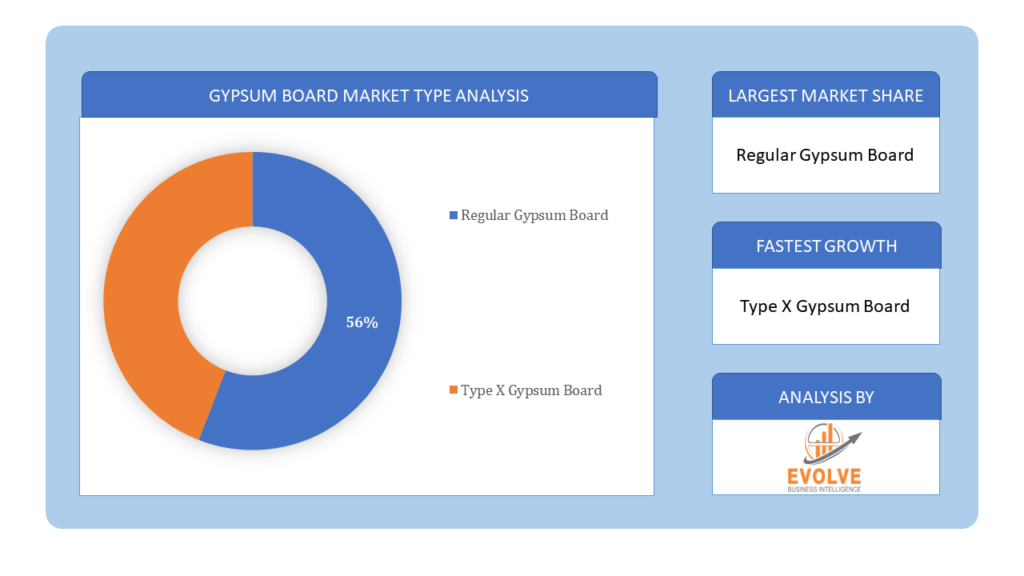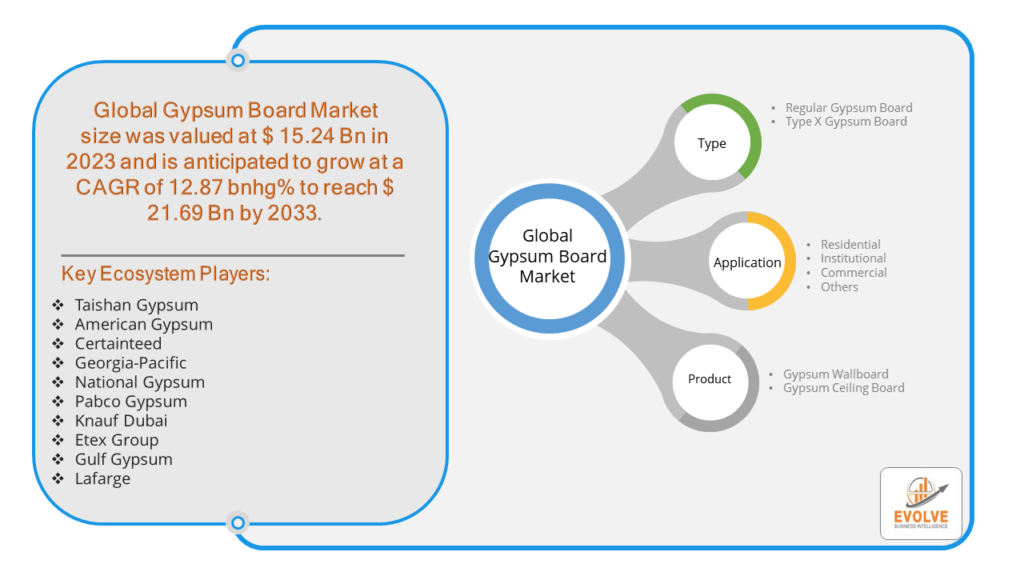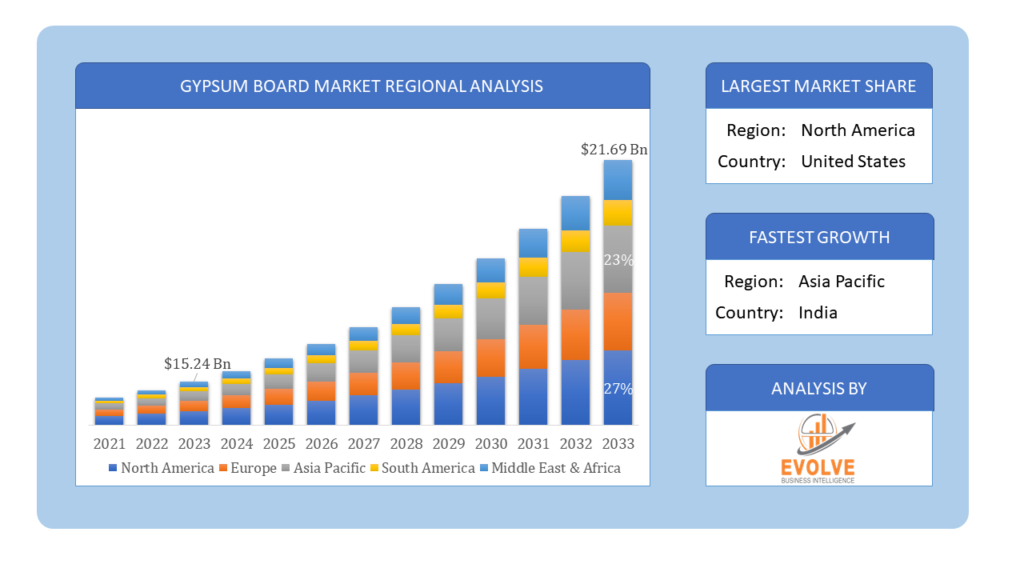Gypsum Board Market Overview
The Gypsum Board Market Size is expected to reach USD 21.69 Billion by 2033. The Gypsum Board Market industry size accounted for USD 15.24 Billion in 2023 and is expected to expand at a compound annual growth rate (CAGR) of 12.87% from 2023 to 2033. The Gypsum Board Market refers to the global industry involved in the production, distribution, and sale of gypsum boards, also known as drywall, plasterboard, or wallboard. Gypsum boards are construction materials used primarily for wall and ceiling applications in residential, commercial, and industrial buildings. These boards are made from a core of gypsum, a naturally occurring mineral, covered with paper on both sides.
Overall, the Gypsum Board Market is driven by the growth in construction activities, demand for sustainable building materials, and advancements in manufacturing technologies.
Global Gypsum Board Market Synopsis
The The COVID-19 pandemic had a significant impact on the Gypsum Board Market. The pandemic led to global supply chain disruptions, affecting the availability of raw materials, including gypsum, and other components required for gypsum board production. Lockdowns and restrictions in various countries caused delays in transportation and logistics, impacting the timely delivery of products. The pandemic caused labour shortages in the construction and manufacturing sectors due to health concerns, quarantine measures, and travel restrictions. Reduced workforce availability impacted production capacities and project timelines. While the demand for new construction decreased, there was an increase in renovation and remodeling activities as people spent more time at home and invested in home improvement projects. The pandemic heightened awareness of health and safety in buildings, leading to increased demand for materials with better indoor air quality and antimicrobial properties.
Gypsum Board Market Dynamics
The major factors that have impacted the growth of Gypsum Board Market are as follows:
Drivers:
Ø Technological Advancements
Innovations in gypsum board manufacturing technologies, such as lightweight boards, improved fire resistance, and enhanced sound insulation properties, are attracting more customers and expanding the market. Rapid urbanization and population growth, particularly in developing countries, are leading to increased demand for residential and commercial buildings, thereby boosting the demand for gypsum boards. The expansion of the construction industry, driven by infrastructure development, real estate growth, and government initiatives for affordable housing, significantly fuels the demand for gypsum boards. Increasing awareness and implementation of sustainable and green building practices are driving the demand for eco-friendly construction materials. Gypsum boards, being recyclable and having a lower environmental impact, are preferred in green building projects.
Restraint:
- Perception of Fluctuating Raw Material Prices
The cost of gypsum, the primary raw material for gypsum boards, can be volatile due to factors such as mining regulations, supply chain disruptions, and changes in demand. Fluctuating prices can affect production costs and profit margins for manufacturers. The installation of gypsum boards can be labor-intensive and may require skilled labor, leading to higher installation costs. This can be a barrier, especially in cost-sensitive markets.
Opportunity:
⮚ Rising Demand for Sustainable Building Materials:
As environmental awareness increases, there is a growing demand for sustainable and eco-friendly building materials. Gypsum boards, being recyclable and having a lower environmental impact, can capitalize on this trend by promoting their green building benefits. The trend towards home renovation and remodeling, driven by the need to upgrade existing structures and improve living spaces, provides an opportunity for gypsum board manufacturers to cater to the growing demand for high-quality, easy-to-install interior finishing materials. The expansion of commercial spaces, including offices, retail outlets, hotels, and entertainment complexes, creates a demand for durable and aesthetically pleasing interior materials. Gypsum boards can benefit from this trend by offering versatile design solutions.
Gypsum Board Market Segment Overview
By Type
 Based on Type, the market is segmented based on Regular Gypsum Board and Type X Gypsum Board. The Regular Gypsum Board segment dominant the market. It’s driven by its cost-effectiveness, ease of installation, and widespread use in standard construction applications. Regular gypsum boards are relatively inexpensive compared to other building materials, making them a popular choice for budget-conscious projects.
Based on Type, the market is segmented based on Regular Gypsum Board and Type X Gypsum Board. The Regular Gypsum Board segment dominant the market. It’s driven by its cost-effectiveness, ease of installation, and widespread use in standard construction applications. Regular gypsum boards are relatively inexpensive compared to other building materials, making them a popular choice for budget-conscious projects.
By Application
Based on Application, the market segment has been divided into the Residential, Institutional, Commercial and Others. Residential accounted for the largest market share due to the growing renovation and remodeling activities of homeowners to enhance the overall look of their space. Besides this, the installation process of gypsum boards is easy and hassle-free and ensures less wastage, which is propelling the growth of the market.
By Product
Based on Product, the market segment has been divided into the Gypsum Wallboard and Gypsum Ceiling Board. The Gypsum Wallboard segment dominant the market. The wallboard is a key component in creating false ceilings or drops ceilings. These ceilings not only conceal structural elements but also allow for incorporating design elements and services. False ceilings enhance the overall aesthetics of space while providing practical benefits such as soundproofing and improved acoustics. The primary and most common use of wallboard is in constructing interior walls.
Global Gypsum Board Market Regional Analysis
Based on region, the global Gypsum Board Market has been divided into North America, Europe, Asia-Pacific, the Middle East & Africa, and Latin America. North America is projected to dominate the use of the Gypsum Board Market followed by the Asia-Pacific and Europe regions.
 Gypsum Board North America Market
Gypsum Board North America Market
North America holds a dominant position in the Gypsum Board Market. Well-established market with high demand for residential, commercial, and industrial construction. Strong emphasis on sustainable and green building practices and Advanced manufacturing technologies and presence of major industry players. Its main key drivers are growth in renovation and remodeling activities and Increasing adoption of lightweight construction materials.
Gypsum Board Asia-Pacific Market
The Asia-Pacific region has indeed emerged as the fastest-growing market for the Gypsum Board Market industry. Rapidly growing market due to urbanization, population growth, and economic development. Significant demand for residential and commercial construction and Increasing investments in infrastructure and real estate and Rising disposable incomes and growing demand for better quality housing.
Competitive Landscape
The global Gypsum Board Market is highly competitive, with numerous players offering a wide range of software solutions. The competitive landscape is characterized by the presence of established companies, as well as emerging startups and niche players. To increase their market position and attract a wide consumer base, the businesses are employing various strategies, such as product launches, and strategic alliances.
Prominent Players:
- Taishan Gypsum
- American Gypsum
- Certainteed
- Georgia-Pacific
- National Gypsum
- Pabco Gypsum
- Knauf Dubai
- Etex Group
- Gulf Gypsum
- Lafarge
Key Development
In Feb-2024, Saint-Gobain Group has completed the acquisition of International Cellulose Corporation, a manufacturer of commercial specialty insulation products. Through this acquisition, International Cellulose Corporation will strengthen the position of Saint-Gobain in light and sustainable construction with its fireproofing and insulation solutions. Additionally, it will enhance energy conservation and efficiency in commercial spaces.
Scope of the Report
Global Gypsum Board Market, by Type
- Regular Gypsum Board
- Type X Gypsum Board
Global Gypsum Board Market, by Application
- Residential
- Institutional
- Commercial
- Others
Global Gypsum Board Market, by Product
- Gypsum Wallboard
- Gypsum Ceiling Board
Global Gypsum Board Market, by Region
- North America
- US
- Canada
- Mexico
- Europe
- UK
- Germany
- France
- Italy
- Spain
- Benelux
- Nordic
- Rest of Europe
- Asia Pacific
- China
- Japan
- South Korea
- Indonesia
- Austalia
- Malaysia
- India
- Rest of Asia Pacific
- South America
- Brazil
- Argentina
- Rest of South America
- Middle East & Africa
- Saudi Arabia
- UAE
- Egypt
- South Africa
- Rest of Middle East & Africa
| Parameters | Indicators |
|---|---|
| Market Size | 2033: $21.69 Billion |
| CAGR | 12.87% CAGR (2023-2033) |
| Base year | 2022 |
| Forecast Period | 2023-2033 |
| Historical Data | 2021 |
| Report Coverage | Revenue Forecast, Competitive Landscape, Growth Factors, and Trends |
| Key Segmentations | Type, Application, Product |
| Geographies Covered | North America, Europe, Asia-Pacific, Latin America, Middle East, Africa |
| Key Vendors | Taishan Gypsum, American Gypsum, Certainteed, Georgia-Pacific, National Gypsum, Pabco Gypsum, Knauf Dubai, Etex Group, Gulf Gypsum and Lafarge. |
| Key Market Opportunities | • Rising Demand for Sustainable Building Materials • Renovation and Remodeling Trends |
| Key Market Drivers | • Technological Advancements • Urbanization and Population Growth |
REPORT CONTENT BRIEF:
- High-level analysis of the current and future Gypsum Board Market trends and opportunities
- Detailed analysis of current market drivers, restraining factors, and opportunities in the future
- Gypsum Board Market historical market size for the year 2021, and forecast from 2023 to 2033
- Gypsum Board Market share analysis at each product level
- Competitor analysis with detailed insight into its product segment, Government & Defense strength, and strategies adopted.
- Identifies key strategies adopted including product launches and developments, mergers and acquisitions, joint ventures, collaborations, and partnerships as well as funding taken and investment done, among others.
- To identify and understand the various factors involved in the global Gypsum Board Market affected by the pandemic
- To provide a detailed insight into the major companies operating in the market. The profiling will include the Government & Defense health of the company’s past 2-3 years with segmental and regional revenue breakup, product offering, recent developments, SWOT analysis, and key strategies.







